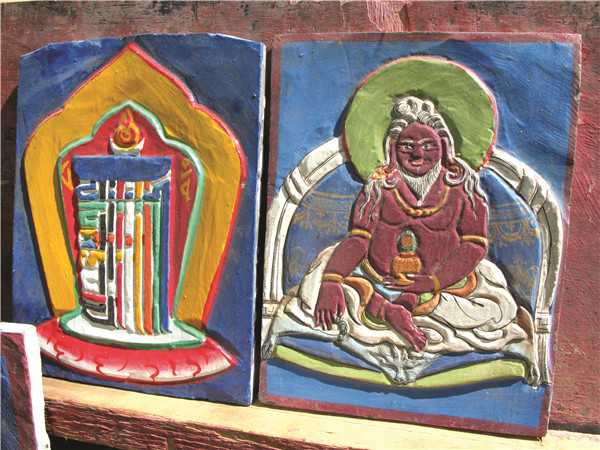Craftsman continues ancient tradition of prayer-stone carvings
Updated: 2015-03-27 11:38
By Phuntsog Tashi and Palden Nyima in Lhasa, Tibet(China Daily USA)
|
|||||||||
 |
|
Completed prayer stones displayed at the stall. |
Olo Tsering headed to Tibet's regional capital Lhasa two decades ago. He has dabbled in various kinds of work but finally chose to focus on prayer-stone carving.
His pieces include various Buddha images and Tibetan scriptures, such as the famous Om mani padme hum, the mantra of the bodhisattva of compassion, Avalokiteshvara.
The craftsman said the carvings are an important part of Tibetan culture.
"I am the third-generation prayer-stone carver in my family and I hope this tradition will last forever," he said.
Olo Tsering said he has trained more than 10 apprentices, including his son.
"Prayer-stone carving dates back about 1,300 years. It is like a venerable river and I don't want see to it drying up one day," he said.
Olo Tsering's son is in middle school and he trained the boy during the school holidays.
It takes about two years to become a qualified prayer-stone carver, he said.
"Learning how to carve the scriptures requires at least two months. It takes two years for the images," he said.
Olo Tsering said carvers also have to be religious. They must desire to inherit the traditional art, be able to read and write, and work diligently.
Carving a long mantra takes a long time and much energy. A short work of four to six syllables requires several minutes.
"The shortest mantra has four syllables, and I can carve 300 to 400 plates in one day," he said.
- Australia announces it will join China-proposed bank
- Germanwings pilot planned big gesture, says ex-girlfriend
- 'Behind-the-scenes' visit at Paris Zoological Park
- Migrants risk lives crossing into Europe
- US denies visa to young man for transplant
- Germanwings' co-pilot 100 percent fit to fly: Lufthansa CEO

 World leaders open Boao Forum for Asia 2015
World leaders open Boao Forum for Asia 2015
 Buildings covered by fog in China's Qingdao
Buildings covered by fog in China's Qingdao
 Across America over the week (from March 20 to 27)
Across America over the week (from March 20 to 27)
 Walking tall
Walking tall
 Press photo competition winners announced
Press photo competition winners announced
 Strange but true: Gator takes a stroll on Florida golf course
Strange but true: Gator takes a stroll on Florida golf course
 Top 9 hot-selling foreign products for Chinese babies
Top 9 hot-selling foreign products for Chinese babies
 French photographer captures Beijing in the '80s
French photographer captures Beijing in the '80s
Most Viewed
Editor's Picks

|

|

|

|

|

|
Today's Top News
Asian countries to seek win-win co-op: Xi
'Made in China' to 'Made in USA'
More countries to join China-backed investment bank
Grassland city looks to cloud computing
Scenic Hohhot wants to be smart based on emerging industries
Motive examined after
'deliberate crash'
Chinese CEO compares Apple Inc to Hitler
China's investment opportunities lauded
US Weekly

|

|







